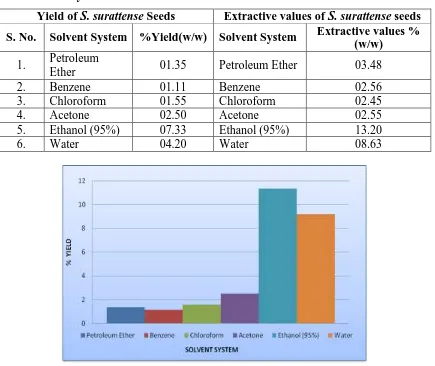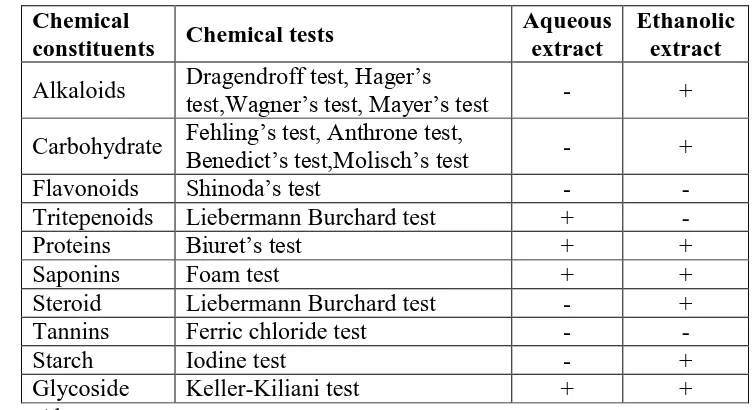DIURETIC ACTIVITY OF ETHANOLIC EXTRACT OF PLANT
SOLANUM SURATTENSE
SEEDS
Hemant Swami*1, Mahendra Kumar Panigrahi2 and Supriya Pradhan3
1
Institute of Professional Studies-College of Pharmacy, Gwalior (M.P.) 474011.
2
Hi-Tech College of Pharmacy, I-Tech Medical College and Hospital Campus, Pandara, Rasulgarh, Bhubaneswar-751025, Odisha.
3
P.G. Dept. of Pharmacology, M.K.C.G. Medical College, Berhampur, Ganjam
ABSTRACT
In the present study the diuretic activity of ethanolic extract of seeds of plant Solanum surattense has been carried out. The dried seeds of
Solanum Surattense were subjected to successive extraction using the solvents (Petroleum ether, Ethanol and water) in increasing order of polarity. The phytochemical studies such as determination of yield, extractive values and ash value have been performed. Phytochemical screening has also been performed for the detection of phyto-constituents. IR-Spectroscopy and TLC of ethanolic extract of S. surattense seed was also performed .The ethanol extract was selected for further study. The diuretic potential of ethanolic extract was
assessed in albino rats using in-vivo Lipschitz test model. The volumes of urine, urinary concentration of sodium potassium and chloride ions were selected parameters for diuretic activity. Furosemide was used as standard and ethanol extract at 500 mg/kg body weight was used for diuretic activity. It was found that treatment with seed extract of S. surattense
(ethanolic) markedly results in excretion of Na+, K+ and Cl- ions. The results show that the seed of Solanum surattense have diuretic activity as compared with Furosemide as standard drug.
KEYWORDS: Solanum Surattense, seeds, Ethanolic extract, Diuretic activity, Furosemide.
INTRODUCTION
Diuretics are the drugs that increase the rate of urination. There are several classes of diuretics and they increase the excretion of water from the body by acting through different
Volume 6, Issue 01, 835-840. Research Article ISSN 2277– 7105
*Corresponding Author
Hemant Swami
Institute of Professional
Studies-College of
Pharmacy, Gwalior (M.P.)
474011.
Article Received on 02 Nov. 2016,
Revised on 24 Nov. 2016, Accepted on 14 Dec. 2016
mechanisms. Diuretics are capable of increasing the flow of urine and are useful in the treatment of diseases related with the retention of fluids.[1],[2] The dried seeds of Solanum surattense were subjected to successive extraction using the solvents (Petroleum ether, Ethanol and water) in increasing order of polarity.[3] The objective of present study is to minimize the use of synthetic drugs due to their side effects and to reveal the newer and better prospects of herbal remedies to cater the side effects of synthetic compounds and to provide newer molecule with better therapeutic activities.
MATERIAL AND METHOD
The entire plant of Solanum surattense (Kantkari) was collected from Bhander, distict Datia M.P. from the bank of Pahuj river in the month of March-April 2011and also purched from local marke of Gwalior Madhya Pradesh.
The ethanolic extract of Solanum surattense seeds was selected for present study. The volumes of urine, urinary concentration of sodium potassium and chloride ions were selected parameters for diuretic activity. Furosemide was used as standard and ethanol extract at 400 and 600 mg/kg body weight was used for diuretic activity[4]
Percent yield and Extractive values of S.surattense Seeds
200 g coarsely powdered seeds of Solanum surattense was packed in a soxhlet apparatus and successive extracted with petroleum ether, benzene, chloroform, acetone and ethanol (95%) and finally with water through maceration for 72 hrs. The mark was dried in an oven below 50 0C before being extracted with the next solvent. In case of water the mark was obtained after extraction with ethanol was dried and macerated with chloroform water for 72 hrs .The completion of extraction was confirmed by evaporating few drops of the liquid extract on watch glass and ensuring that no residue remained after evaporating the solvent. The solvent was evaporated by using rotary evaporator from each extracts. The extracts were than dried
and weighed and percentage was recorded.
5.0 g of coarsely powdered air-dried material was accurately weighed and placed in a glass-Stoppard conical flask. Powder was then macerated with 100 ml of the solvent (Water/ethanol) concerned for 6 hours, shaking frequently, and then was allowed to stand for 18 hours. It was then filtered rapidly taking care not to lose any solvent; 25 ml of this filtrate was transferred to a tarred flat-bottomed dish and was evaporated to dryness on a water-bath.
was weighed without delay. The content of extractable matter in mg per g of air-dried material was then calculated.
Table 1: Percent yield and Extractive value of S.surattense seeds
Yield of S. surattense Seeds Extractive values of S. surattense seeds
S. No. Solvent System %Yield(w/w) Solvent System Extractive values %
(w/w)
1. Petroleum
Ether 01.35 Petroleum Ether 03.48
2. Benzene 01.11 Benzene 02.56
3. Chloroform 01.55 Chloroform 02.45
4. Acetone 02.50 Acetone 02.55
5. Ethanol (95%) 07.33 Ethanol (95%) 13.20
[image:3.595.145.450.544.743.2]6. Water 04.20 Water 08.63
Fig.1 Effect of solvent system on yield of extracts of S. surattense seeds
Table 2: Qualitative Phytochemical Screening of S. surattense Seed
Chemical
constituents Chemical tests
Aqueous extract
Ethanolic extract
Alkaloids Dragendroff test, Hager’s
test,Wagner’s test, Mayer’s test - +
Carbohydrate Fehling’s test, Anthrone test,
Benedict’s test,Molisch’s test - +
Flavonoids Shinoda’s test - -
Tritepenoids Liebermann Burchard test + -
Proteins Biuret’s test + +
Saponins Foam test + +
Steroid Liebermann Burchard test - +
Tannins Ferric chloride test - -
Starch Iodine test - +
Glycoside Keller-Kiliani test + +
+Present, -Absent
Chromatographic Studies
(i). Silica gel G was weighed in required quantity.
(ii). Homogeneous slurry was prepared with sufficient amount of distilled water. (iii).Slurry was poured on TLC glass plates uniformly in thin layer.
(iv).The coated plate was allowed to dry in air and activated by heating in hot air oven at 100-105 0 C for one hour.
(v). The samples were prepared with respective solvent.
(vi).Then with the help of the capillary tube, the samples were applied as spots on TLC plates, which were developed in TLC chamber, previously saturated with solvent system. (vii). By trial and error method, ethanol and aqueous extracts isolation and resolution of
spots with following solvents Systems: 1. Chloroform: Ethyl acetate (60:40)
2. Ethyl acetate: Formic Cid: Glacial acetic acid: water (50:11:11:28)
The different spots developed in each solvent system were identified under UV-light at wavelength 365 nm and Rf values were calculated.
Table: 3 Results of Thin layer chromatography
S.no. Extract Solvent system No. of
spots Colour of spots Rf value
1. Ethanolic Extract
Chloroform: Ethyl acetate (60:40)
3 Light yellowish
[image:4.595.105.482.90.295.2]2 Aqueous Extract
Ethyl acetate: Formic Cid: Glacial acetic
acid: water (50:11:11:28)
1 Light greenish 0.62
Diuretic activity
Male albino rats weighing 200-300 gm of either sex were used. Twenty male albino rats weighing were divided into 4 groups of 5 animals each and deprived of food and water for 18 hours. All the rats received priming dose of normal saline (25ml/kg) orally. Both the extracts and Furosemide (Standard) were dissolved in a normal saline. Group I served as control in which only normal saline (25ml/kg) was administered through intraperitoneal route. Group II served as standard received Furosemide (20mg/kg). Rest of the groups served as treated
groups. Group III and Group IV received ethanolic and water extract of S. surattense seeds .Immediately after administration, the rats (one in each cage) were placed in metabolic cages specially designed to separate urine and faeces and kept at room temperature of 25±0.5ºC. The urine was collected in a measuring cylinder up to 6 h. The content of Na+, K+ and Cl- in the urine was estimated by UV-spectrophotometer and results were compared with standard Furosemide.
The ED50 was found 600, mg/kg body weight, on the basis of symptoms.[5] The sodium,
potassium and Chloride contents of the collected urine were estimated by UV-spectrophotometer (Jasco630V).
RESULTS AND DISCUSSION
The concentration of Sodium, Potassium and Chloride ions was estimated by using standard chemicals and reagent with of UV-Spectrophotometer.
Table: 4 Results of diuretic activity of Ethanolic Extract of seeds of plant S.surattense
Name of the drug/extract
Dose (mg/kg)
Urine volume (ml)
Concentration of ions (mEq/L)
Na+ K+ Cl-
Control (G1) - 0.57 ± 0.02 52±1.9 09.4 ±0.27 36 ±1.50 Standard (G2)
CONCLUSION
Ethanolic extract of S.surattense seed (600 mg/kg body weight) exhibits significant diuretic activity as compared to Furosemide standard drug (20mg/kg body weight) as it markedly changes the concentration of Na+, K+ and Cl- as compared with Furosemide standard drug.
REFERENCES
1. Iyengar MA., Bibliography of Investigated Indian Medicinal Plants: Kasturba Medical College, Manipal, 1976; 144.
2. Wagner H, Wolff P., New Natural products and Plants Drugs with Pharmacological, Biological or Therapeutical Activity: Springer-Verlag, Berlin, 1977; 6.
3. Satyavati GV, Gupta AR, Tandon N., Medicinal Plants of India: II, I.C.M.R., New Delhi; 1987 317.
4. Kumar N, Prakash D, Kumar P., Wound healing activity of Solanum xanthocarpum Schrad & Wendl, fruits: Indian Journal of Natural Product and Resources, 1987; 1(4): 470–475. 5. OECD Guidelines for testing of chemicals, Acute oral toxicity, Environmental Health and

